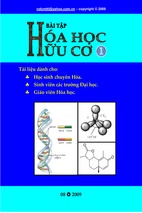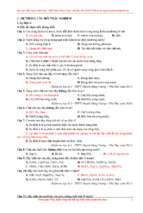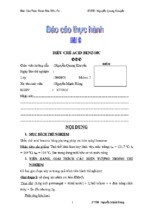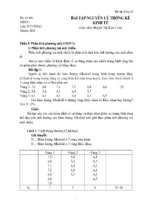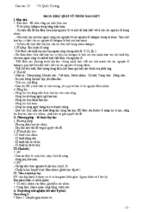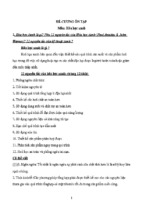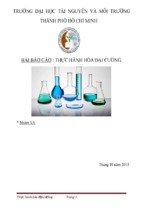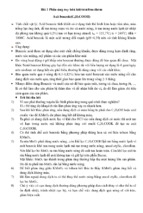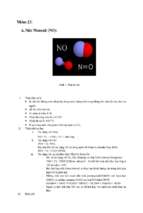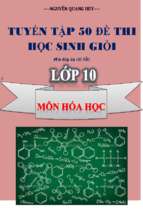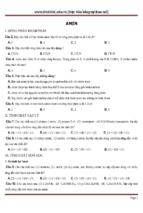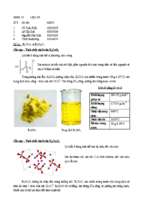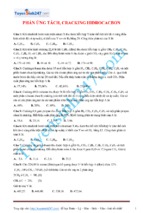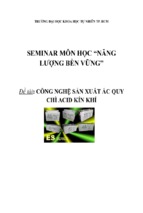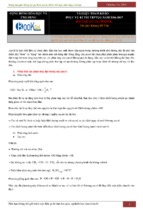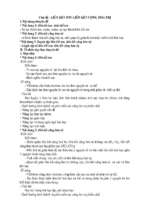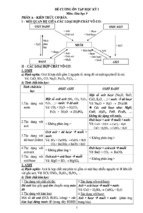Organic Chemistry I as a Second Language, 2e Translating the Basic Concepts - David M. Klein
6753_Klein_00.qxd
5/1/07
5:02 PM
Page ii
6753_Klein_00.qxd
5/1/07
5:02 PM
Page i
6753_Klein_00.qxd
5/1/07
5:02 PM
Page ii
6753_Klein_00.qxd
5/15/07
2:14 PM
Page iii
ORGANIC CHEMISTRY I
AS A SECOND
LANGUAGE
Second Edition
DR. DAVID R. KLEIN
Johns Hopkins University
JOHN WILEY & SONS, INC.
6753_Klein_00.qxd
5/1/07
Marketing Manager
Production Manager
Production Editor
Cover Designer
5:02 PM
Page iv
Amanda Wygal
Pamela Kennedy
Barbara Russiello
Norm Christiansen
This book was set in 10/12 Times Roman by Matrix Publishing Services and printed and
bound by Courier/Westford. The cover was printed by Courier/Westford.
Recognizing the importance of preserving what has been written, it is a policy of John
Wiley & Sons, Inc., to have books of enduring value published in the United States printed
on acid-free paper, and we exert our best efforts to that end.
Copyright © 2008 John Wiley & Sons, Inc. All rights reserved.
No part of this publication may be reproduced, stored in a retrieval system, or transmitted
in any form or by any means, electronic, mechanical, photocopying, recording, scanning
or otherwise, except as permitted under Sections 107 or 108 of the 1976 United States
Copyright Act, without either the prior written permission of the Publisher, or authorization
through payment of the appropriate per-copy fee to the Copyright Clearance Center, Inc.
222 Rosewood Drive, Danvers, MA 01923, website www.copyright.com. Requests to the
Publisher for permission should be addressed to the Permissions Department, John Wiley &
Sons, Inc., 111 River Street, Hoboken, NJ 07030, (201)748-6011, fax (201)748-6008,
website http://www.wiley.com/go/permissions.
To order books or for customer service please call 1-800-CALL WILEY (225-5945).
ISBN-13
978-0470-12929-6
Printed in the United States of America
10 9 8 7 6 5 4 3 2 1
6753_Klein_00.qxd
5/1/07
5:02 PM
Page v
INTRODUCTION
HOW TO USE THIS BOOK
Is organic chemistry really as tough as everyone says it is? The answer is yes and no.
Yes, because you will spend more time on organic chemistry than you would spend
in a course on underwater basket weaving. And no, because those who say its so
tough have studied inefficiently. Ask around, and you will find that most students
think of organic chemistry as a memorization game. This is not true! Former organic
chemistry students perpetuate the false rumor that organic chemistry is the toughest
class on campus, because it makes them feel better about the poor grades that they
received.
If it’s not about memorizing, then what is it? To answer this question, let’s
compare organic chemistry to a movie. Picture in your mind a movie where the plot
changes every second. The “Usual Suspects” is an excellent example. If you’re in a
movie theatre watching a movie like that, you can’t leave even for a second because
you would miss something important to the plot. So you try your hardest to wait until
the movie is over before going to the bathroom. Sound familiar?
Organic chemistry is very much the same. It is one long story, and the
story actually makes sense if you pay attention. The plot constantly develops, and
everything ties into the plot. If your attention wanders for too long, you could
easily get lost.
OK, so it’s a long movie. But don’t I need to memorize it? Of course, there are
some things you need to memorize. You need to know some important terminology
and some other concepts that require a bit of memorization, but the amount of pure
memorization is not that large. If I were to give you a list of 100 numbers, and I
asked you to memorize them all for an exam, you would probably be very upset by
this. But at the same time, you can probably tell me at least 10 telephone numbers
off the top of your head. Each one of those has 10 digits (including the area codes).
You never sat down to memorize all 10 telephone numbers. Rather, over time you
slowly became accustomed to dialing those numbers until the point that you knew
them. Let’s see how this works in our movie analogy.
You probably know at least one person who has seen one movie more than five
times and can quote every line by heart. How can this person do that? It’s not because he or she tried to memorize the movie. The first time you watch a movie, you
learn the plot. After the second time, you understand why individual scenes are necessary to develop the plot. After the third time, you understand why the dialogue was
necessary to develop each scene. After the fourth time, you are quoting many of the
lines by heart. Never at any time did you make an effort to memorize the lines. You
v
6753_Klein_00.qxd
vi
5/1/07
5:02 PM
Page vi
INTRODUCTION
know them because they make sense in the grand scheme of the plot. If I were to give
you a screenplay for a movie and ask you to memorize as much as you can in 10
hours, you would probably not get very far into it. If, instead, I put you in a room for
10 hours and played the same movie over again five times, you would know most of
the movie by heart, without even trying. You would know everyone’s names, the
order of the scenes, much of the dialogue, and so on.
Organic chemistry is exactly the same. It’s not about memorization. It’s all
about making sense of the plot, the scenes, and the individual concepts that make up
our story. Of course you will need to remember all of the terminology, but with
enough practice, the terminology will become second nature to you. So here’s a brief
preview of the plot.
THE PLOT
The first half of our story builds up to reactions, and we learn about the characteristics of molecules that help us understand reactions. We begin by looking at atoms,
the building blocks of molecules, and what happens when they combine to form
bonds. We focus on special bonds between certain atoms, and we see how the nature of bonds can affect the shape and stability of molecules. At this point, we need
a vocabulary to start talking about molecules, so we learn how to draw and name
molecules. We see how molecules move around in space, and we explore the relationships between similar types of molecules. At this point, we know the important
characteristics of molecules, and we are ready to use our knowledge to explore
reactions.
Reactions take up the rest of the course, and they are typically broken down
into chapters based on functional groups. Within each of these chapters, there is actually a subplot that fits into the grand story.
HOW TO USE THIS BOOK
This book will help you study more efficiently so that you can avoid wasting countless hours. It will point out the major scenes in the plot of organic chemistry. The
book will review the critical principles and explain why they are relevant to the rest
of the course. In each section, you will be given the tools to better understand your
textbook and lectures. In other words, you will learn the language of organic chemistry. This book cannot replace your textbook, your lectures, or other forms of studying. This book is not the Cliff Notes of Organic Chemistry. It focuses on the basic
concepts that will empower you to do well if you go to lectures and study in addition to using this book. To best use this book, you need to know how to study in this
course.
6753_Klein_00.qxd
5/1/07
5:02 PM
Page vii
INTRODUCTION
vii
HOW TO STUDY
There are two separate aspects to this course:
1. Understanding principles
2. Solving problems
Although these two aspects are completely different, instructors will typically gauge
your understanding of the principles by testing your ability to solve problems. So
you must master both aspects of the course. The principles are in your textbook and
in your lecture notes, but you must discover how to solve problems. Most students
have a difficult time with this task. In this book, we explore some step-by-step
processes for analyzing problems. There is a very simple habit that you must form
immediately: learn to ask the right questions.
If you go to a doctor with a pain in your stomach, you will get a series of questions: How long have you had the pain? Where is the pain? Does it come and go, or
is it constant? What was the last thing you ate? and so on. The doctor is doing two
very important and very different things. First, he has learned the right questions to
ask. Next, he applies the knowledge he has together with the information he has
gleaned to arrive at the proper diagnosis. Notice that the first step is asking the right
questions.
Let’s imagine that you want to sue McDonald’s because you spilled hot coffee
in your lap. You go to an attorney and she asks you a series of questions that enable
her to apply her knowledge to your case. Once again, the first step is asking questions.
In fact, in any profession or trade, the first step of diagnosing a problem is always to ask questions. Let’s say you are trying to decide if you really want to be a
doctor. There are some tough, penetrating questions that you should be asking yourself. It all boils down to learning how to ask the right questions.
The same is true with solving problems in this course. Unfortunately, you are
expected to learn how to do this on your own. In this book, we will look at some
common types of problems and we will see what questions you should be asking in
those circumstances. More importantly, we will also be developing skills that will
allow you to figure out what questions you should be asking for a problem that you
have never seen before.
Many students freak out on exams when they see a problem that they can’t do.
If you could hear what was going on in their minds, it would sound something like
this: “I can’t do it . . . I’m gonna flunk.” These thoughts are counterproductive and a
waste of precious time. Remember that when all else fails, there is always one question that you can ask yourself: “What questions should I be asking right now?”
The only way to truly master problem-solving is to practice problems every
day, consistently. You will never learn how to solve problems by just reading a book.
You must try, and fail, and try again. You must learn from your mistakes. You must
get frustrated when you can’t solve a problem. That’s the learning process.
The worst thing you can do is to read through the solutions manual and think
that you now know how to solve problems. It doesn’t work that way. If you want an
6753_Klein_00.qxd
viii
5/1/07
5:02 PM
Page viii
INTRODUCTION
A, you will need to sweat a little (no pain, no gain). And that doesn’t mean that you
should spend day and night memorizing. Students who focus on memorizing will experience the pain, but few of them will get an A.
The simple formula: Review the principles until you understand how each of
them fits into the plot; then focus all of your remaining time on solving problems.
Don’t worry. The course is not that bad if you approach it with the right attitude. This
book will act as a road map for your studying efforts.
6753_Klein_00.qxd
5/1/07
5:02 PM
Page ix
CONTENTS
Introduction
iii
CHAPTER 1
BOND-LINE DRAWINGS
1.1
1.2
1.3
1.4
1.5
1.6
1
How to Read Bond-Line Drawings 1
How to Draw Bond-Line Drawings 5
Mistakes to Avoid 7
More Exercises 8
Identifying Formal Charges 10
Finding Lone Pairs That Are Not Drawn
CHAPTER 2
RESONANCE
14
20
2.1
2.2
2.3
2.4
2.5
2.6
2.7
What Is Resonance? 20
Curved Arrows: The Tools for Drawing Resonance Structures 21
The Two Commandments 24
Drawing Good Arrows 27
Formal Charges in Resonance Structures 29
Drawing Resonance Structures—Step by Step 33
Drawing Resonance Structures—By Recognizing Patterns 38
A Lone Pair Next to a Pi Bond 38
A Lone Pair Next to a Positive Charge 41
A Pi Bond Next to a Positive Charge 43
A Pi Bond Between Two Atoms, Where One of Those Atoms Is
Electronegative (N, O, etc.) 44
Pi Bonds Going All the Way Around a Ring 45
2.8 Assessing the Relative Importance of Resonance Structures 47
CHAPTER 3
3.1
3.2
3.3
3.4
3.5
3.6
3.7
3.8
ACID–BASE REACTIONS
53
Factor 1—What Atom Is the Charge on? 54
Factor 2—Resonance 57
Factor 3—Induction 62
Factor 4—Orbitals 66
Ranking the Four Factors 67
Quantitative Measurement (pKa values) 71
Predicting the Position of Equilibrium 71
Showing a Mechanism 73
ix
6753_Klein_00.qxd
x
5/1/07
5:02 PM
Page x
CONTENTS
CHAPTER 4
GEOMETRY
76
4.1 Orbitals and Hybridization States
4.2 Geometry 80
CHAPTER 5
5.1
5.2
5.3
5.4
5.5
5.6
5.7
5.8
106
CONFIGURATIONS
134
Locating Stereocenters 135
Determining the Configuration of a Stereocenter
Nomenclature 146
Drawing Enantiomers 151
Diastereomers 156
Meso Compounds 157
Drawing Fischer Projections 160
Optical Activity 165
CHAPTER 8
8.1
8.2
8.3
8.4
8.5
8.6
CONFORMATIONS
104
How to Draw a Newman Projection 107
Ranking the Stability of Newman Projections 111
Drawing Chair Conformations 115
Placing Groups on the Chair 118
Ring Flipping 123
Comparing the Stability of Chairs 129
Don’t Be Confused by the Nomenclature 133
CHAPTER 7
7.1
7.2
7.3
7.4
7.5
7.6
7.7
7.8
84
Functional Group 85
Unsaturation 87
Naming the Parent Chain 89
Naming Substituents 91
Stereoisomerism 95
Numbering 98
Common Names 103
Going from a Name to a Structure
CHAPTER 6
6.1
6.2
6.3
6.4
6.5
6.6
6.7
NOMENCLATURE
76
MECHANISMS
138
167
Curved Arrows 168
Arrow Pushing 173
Drawing Intermediates 175
Nucleophiles and Electrophiles 178
Bases Versus Nucleophiles 179
The Regiochemistry Is Contained Within the Mechanism
182
6753_Klein_00.qxd
5/1/07
5:02 PM
Page xi
CONTENTS
8.7 The Stereochemistry Is Contained Within the Mechanism
8.8 A List of Mechanisms 190
CHAPTER 9
9.1
9.2
9.3
9.4
9.5
9.6
9.7
SUBSTITUTION REACTIONS
211
The Mechanisms 211
Factor 1—The Electrophile (Substrate) 214
Factor 2—The Nucleophile 217
Factor 3—The Leaving Group 220
Factor 4—The Solvent 223
Using All Four Factors 226
Substitution Reactions Teach Us Some Important Lessons
CHAPTER 10
10.1
10.2
10.3
10.4
10.5
10.6
10.7
ELIMINATION REACTIONS
227
229
Mechanisms (E1 and E2) 230
Factor 1—The Substrate 231
Factor 2—The Base 232
Factor 3—The Leaving Group 235
Factor 4—Solvent Effects 236
Using All of the Factors 236
Elimination Reactions—Regiochemistry and Stereochemistry
CHAPTER 11
ADDITION REACTIONS
242
11.1 Terminology Describing Regiochemistry 242
11.2 Terminology Describing Stereochemistry 244
11.3 Adding H and H 253
11.4 Adding H and X, Markovnikov 256
11.5 Adding H and Br, Anti-Markovnikov 263
11.6 Adding H and OH, Markovnikov 268
11.7 Adding H and OH, Anti-Markovnikov 272
11.8 Synthesis Techniques 277
11.9 Adding Br and Br; Adding Br and OH 285
11.10 Adding OH and OH, Anti 290
11.11 Adding OH and OH, Syn 293
11.12 Oxidative Cleavage of an Alkene 296
CHAPTER 12
12.1
12.2
12.3
12.4
185
PREDICTING PRODUCTS
299
General Tips for Predicting Products 299
Getting Practice 300
Substitution Versus Elimination Reactions
Looking Forward 315
311
238
xi
6753_Klein_00.qxd
xii
5/1/07
Page xii
CONTENTS
CHAPTER 13
13.1
13.2
13.3
13.4
5:02 PM
SYNTHESIS
316
One-step Syntheses 318
Multistep Syntheses 329
Retrosynthetic Analysis 330
Creating Your Own Problems
Answer Key
Index 354
333
331
6753_Klein_01.qxd
5/1/07
5:03 PM
Page 1
1
CHAPTER
BOND-LINE DRAWINGS
To do well in organic chemistry, you must first learn to interpret the drawings that
organic chemists use. When you see a drawing of a molecule, it is absolutely critical that you can read all of the information contained in that drawing. Without this
skill, it will be impossible to master even the most basic reactions and concepts.
Molecules can be drawn in many ways:
H H H H
H C
O
C C
C
C
H
C H
C H
H H
HH
(CH3)2CHCH=CHCOCH3
O
Without a doubt, the last structure (bond-line drawing) is the quickest to
draw, the quickest to read, and the best way to communicate. Open your textbook
to any page in the second half and you will find that every page is plastered with
bond-line drawings. Most students will gain a familiarity with these drawings over
time, not realizing how absolutely critical it is to be able to read these drawings fluently. This chapter will help you develop your skills in reading these drawings
quickly and fluently.
1.1 HOW TO READ BOND-LINE DRAWINGS
Bond-line drawings show the carbon skeleton (the connections of all the carbon
atoms that build up the backbone, or skeleton, of the molecule) with any functional
groups that are attached, such as – OH or – Br. Lines are drawn in a zigzag format,
so that the end of every line represents a carbon atom. For example, the following
compound has 6 carbon atoms:
It is a common mistake to forget that the ends of lines represent carbon atoms as
well. For example, the following molecule has six carbon atoms (make sure you can
count them):
1
6753_Klein_01.qxd
2
5/1/07
5:03 PM
Page 2
CHAPTER 1 BOND-LINE DRAWINGS
Double bonds are shown with two lines, and triple bonds are shown with three
lines:
When drawing triple bonds, be sure to draw them in a straight line rather than zigzag,
because triple bonds are linear (there will be more about this in the chapter on geometry). This can be quite confusing at first, because it can get hard to see just how
many carbon atoms are in a triple bond, so let’s make it clear:
is the same as
so this compound has
6 carbon atoms
C
C
Don’t let triple bonds confuse you. The two carbon atoms of the triple bond and the
two carbons connected to them are drawn in a straight line. All other bonds are
drawn as a zigzag:
H H H H
H C C C C H
H H H H
is drawn like this:
BUT
H
H
H C C C C H
H
H
is drawn like this:
EXERCISE 1.1 Count the number of carbon atoms in each of the following
drawings:
O
Answer The first compound has six carbon atoms, and the second compound has
five carbon atoms:
1
6
2
5
3
O
4
2
1
3
5
4
PROBLEMS Count the number of carbon atoms in each of the following
drawings.
6753_Klein_01.qxd
5/1/07
5:03 PM
Page 3
1.1 HOW TO READ BOND-LINE DRAWINGS
O
1.2 Answer:
O
1.3 Answer:
H
N
3
OH
1.4 Answer:
1.5 Answer:
1.8 Answer:
1.9 Answer:
O
OH
O
1.6 Answer:
1.7 Answer:
O
1.10
Answer:
O
1.11 Answer:
Now that we know how to count carbon atoms, we must learn how to count
the hydrogen atoms in a bond-line drawing of a molecule. The hydrogen atoms are
not shown, and this is why it is so easy and fast to draw bond-line drawings. Here is
the rule for determining how many hydrogen atoms there are on each carbon atom:
neutral carbon atoms always have a total of four bonds. In the following drawing,
the highlighted carbon atom is showing only two bonds:
O
We see only two bonds
connected to this carbon atom
Therefore, it is assumed that there are two more bonds to hydrogen atoms (to give a
total of four bonds). This is what allows us to avoid drawing the hydrogen atoms and
to save so much time when drawing molecules. It is assumed that the average person knows how to count to four, and therefore is capable of determining the number
of hydrogen atoms even though they are not shown.
So you only need to count the number of bonds that you can see on a carbon
atom, and then you know that there should be enough hydrogen atoms to give a total
of four bonds to the carbon atom. After doing this many times, you will get to a point
where you do not need to count anymore. You will simply get accustomed to seeing
these types of drawings, and you will be able to instantly “see” all of the hydrogen
atoms without counting them. Now we will do some exercises that will help you get
to that point.
6753_Klein_01.qxd
4
5/1/07
5:03 PM
Page 4
CHAPTER 1 BOND-LINE DRAWINGS
EXERCISE 1.12 The following molecule has 14 carbon atoms. Count the num-
ber of hydrogen atoms connected to each carbon atom.
O
Answer:
3 bonds,
1H
4 bonds,
no H’s
4 bonds,
no H’s
O
1 bond,
3 H’s
2 bonds,
2 H’s
4 bonds,
no H’s
1 bond,
3 H’s
4 bonds,
no H’s
1 bond,
3 H’s
3 bonds,
1H
3 bonds,
1H
3 bonds,
1H
1 bond,
3 H’s
4 bonds,
no H’s
PROBLEMS For each of the following molecules, count the number of hydrogen
atoms connected to each carbon atom. The first problem has been solved for you (the
numbers indicate how many hydrogen atoms are attached to each carbon).
O
0
2
1.13
H
N
1
2
1
1.14
2
1.15
O
1.16
O
O
OH
1.17
1.18
1.19
1.20
6753_Klein_01.qxd
5/1/07
5:03 PM
Page 5
1.2 HOW TO DRAW BOND-LINE DRAWINGS
5
Now we can understand why we save so much time by using bond-line drawings. Of
course, we save time by not drawing every C and H. But, there is an even larger benefit to using these drawings. Not only are they easier to draw, but they are easier to
read as well. Take the following reaction for example:
H2
(CH3)2CH2CH2COCH3
(CH3)2CH=CHCOCH3
Pt
It is somewhat difficult to see what is happening in the reaction. You need to stare at
it for a while to see the change that took place. However, when we redraw the reaction using bond-line drawings, the reaction becomes very easy to read immediately:
H2
O
O
Pt
As soon as you see the reaction, you immediately know what is happening. In this
reaction we are converting a double bond into a single bond by adding two hydrogen atoms across the double bond. Once you get comfortable reading these drawings, you will be better equipped to see the changes taking place in reactions.
1.2 HOW TO DRAW BOND-LINE DRAWINGS
Now that we know how to read these drawings, we need to learn how to draw them.
Take the following molecule as an example:
H H
H
C
O
H C
C CH3
H C
C
CH3
H
H H
To draw this as a bond-line drawing, we focus on the carbon skeleton, making sure
to draw any atoms other than C and H. All atoms other than carbon and hydrogen
must be drawn. So the example above would look like this:
H H
H
C
O
H C
C CH3
H C
C
CH3
H
H H
O
6753_Klein_01.qxd
6
5/1/07
5:03 PM
Page 6
CHAPTER 1 BOND-LINE DRAWINGS
A few pointers may be helpful before you do some problems.
1. Don’t forget that carbon atoms in a straight chain are drawn in a zigzag format:
H H H H
H C C C C H
H H H H
is drawn like this:
2. When drawing double bonds, try to draw the other bonds as far away from
the double bond as possible:
O
is much better than
O
BAD
3. When drawing zigzags, it does not matter in which direction you start
drawing:
is the same as
PROBLEMS
For each structure below, draw the bond-line drawing in the box
provided.
H H HH H H
H C H C
H
H C C C C C H
H
H H H C
HHH
1.21
HHH
C O H
H C C C H
H
C
HHH
1.22
(CH3)3C–C(CH3)3
1.23
is the same as
- Xem thêm -

